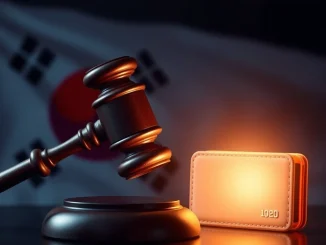
Exciting news for the crypto world! After much anticipation, the United States Congress is gearing up for potential landmark decisions on crypto and stablecoin regulation. Are you ready for a potential shake-up in the digital asset landscape? Let’s dive into the details of the upcoming legislative actions that could redefine how cryptocurrencies operate in the US.
Why is Crypto Regulation Suddenly a Hot Topic?
For years, the cryptocurrency industry has navigated a gray area in terms of regulatory oversight in the US. This lack of clarity has been a double-edged sword. On one hand, it fostered innovation and growth in the nascent industry. On the other, it created uncertainty and risks for investors and businesses alike. Now, it seems the tide is turning as lawmakers on Capitol Hill are pushing for comprehensive rules to govern this rapidly evolving space. Several factors are driving this urgency:
- Investor Protection: As more people invest in cryptocurrencies, there’s growing concern about protecting them from fraud, market manipulation, and risky projects. Recent market events have amplified these concerns.
- Market Stability: The volatility of the crypto market and the potential impact of stablecoins on the broader financial system are raising eyebrows among regulators and policymakers.
- Innovation and Competitiveness: Lawmakers recognize the potential of blockchain technology and digital assets. Smart regulation can foster innovation while ensuring responsible growth and maintaining America’s competitive edge in this emerging tech sector.
Decoding the FIT 21 Crypto Market Structure Bill: What’s the Buzz?
One of the key pieces of legislation gaining momentum is the FIT 21 bill, officially known as the Financial Innovation and Technology for the 21st Century Act. Rep. French Hill, a prominent voice on financial matters in Congress, has announced that a revised draft of this crucial crypto regulation bill is just days away from release. But what exactly does FIT 21 aim to achieve?
In essence, FIT 21 is designed to establish a clear framework for the crypto market structure in the US. It seeks to address a fundamental question: Which regulatory agency should oversee different types of digital assets?
| Key Aspect of FIT 21 | Details |
|---|---|
| CFTC Expansion | The bill proposes to significantly expand the authority of the Commodity Futures Trading Commission (CFTC) to regulate digital assets, particularly those deemed to be commodities. This could include cryptocurrencies like Bitcoin and potentially Ethereum, depending on their classification under the new framework. |
| SEC’s Role Defined | FIT 21 also aims to clarify the role of the Securities and Exchange Commission (SEC). The SEC typically oversees securities, and the bill will likely define which digital assets fall under the SEC’s jurisdiction as securities, and which fall under the CFTC. This distinction is critical for determining regulatory responsibilities and compliance requirements for crypto businesses. |
| Clarity for Businesses | A primary goal of FIT 21 is to provide much-needed clarity for crypto companies operating in the US. By defining the roles of the CFTC and SEC, the bill seeks to reduce regulatory uncertainty and create a more predictable environment for innovation and investment in the digital asset space. |
The revised draft of FIT 21 will be closely scrutinized by the crypto industry, legal experts, and regulators. Any changes from previous versions could signal shifts in approach and impact the bill’s ultimate effectiveness.
Stablecoin Bills on the Horizon: Are We Finally Seeing Progress?
Alongside the FIT 21 bill, stablecoin bills are also gaining traction in Congress. Stablecoins, cryptocurrencies designed to maintain a stable value, typically pegged to fiat currencies like the US dollar, have become increasingly important in the crypto ecosystem. However, their rapid growth and potential systemic risks have drawn regulatory attention.
Rep. Bryan Steil has confirmed that the text of the House stablecoin bill will be introduced very soon. This is a significant step forward, and a markup of the bill is expected shortly after introduction. Markup is a crucial stage in the legislative process where committees review, amend, and refine the bill before it moves to a full House vote.
The push for stablecoin legislation is driven by several factors:
- Payment Innovation: Stablecoins offer the potential for faster, cheaper, and more efficient payments, both domestically and internationally. Regulation could unlock this potential while mitigating risks.
- Financial Stability: Concerns exist about the reserves backing stablecoins and their potential impact on financial stability if not properly regulated. Legislation aims to address these concerns and ensure responsible stablecoin operations.
- Consumer Protection: Clear rules are needed to protect consumers who use stablecoins, ensuring transparency and accountability in the stablecoin ecosystem.
House and Senate Alignment: A Unified Approach to Digital Assets?
One of the most encouraging aspects of the current legislative push is the reported alignment between the House and Senate versions of digital asset legislation. According to The Block, House and Senate versions are about 80% aligned. This level of consensus is rare and suggests a serious commitment from both chambers of Congress to establish a unified framework for digital assets.
This bipartisan effort is crucial for several reasons:
- Faster Progress: Alignment between the House and Senate streamlines the legislative process and increases the likelihood of bills being passed into law more quickly.
- Consistent Regulation: A unified approach ensures a more consistent and predictable regulatory landscape across the US, avoiding a patchwork of state-level regulations that could stifle innovation and create compliance challenges.
- Stronger Signal: Congressional alignment sends a strong signal to the crypto industry and the global community that the US is serious about establishing clear and comprehensive rules for digital assets.
What Does This Mean for the Future of Crypto?
The nearing action on crypto bills and stablecoin bills in Congress represents a potentially transformative moment for the digital asset industry. While the specifics of the legislation are still being finalized, the direction is clear: regulation is coming. But is this a cause for concern or celebration?
For many in the crypto space, clear and well-designed regulation is welcomed. It can bring legitimacy, attract institutional investment, and foster mainstream adoption. However, the devil will be in the details. Overly restrictive or poorly conceived regulations could stifle innovation and drive crypto activity overseas.
Actionable Insights:
- Stay Informed: Keep a close watch on the developments of FIT 21 and stablecoin bills. Follow industry news, legislative updates, and analysis from legal experts.
- Engage with Policymakers: If you are involved in the crypto industry, consider engaging with policymakers and industry associations to voice your perspectives and contribute to the regulatory dialogue.
- Prepare for Compliance: Crypto businesses should start preparing for increased regulatory scrutiny and potential compliance requirements. This may involve strengthening internal controls, enhancing KYC/AML procedures, and seeking legal counsel.
Conclusion: A Pivotal Moment for Crypto Regulation
The coming weeks and months could be pivotal for the future of crypto in the United States. Congress’s move towards action on crypto regulation and stablecoin bills signifies a maturing of the digital asset industry and a growing recognition of its importance in the financial landscape. While challenges and uncertainties remain, the push for a unified and comprehensive regulatory framework offers a glimmer of hope for a more stable, innovative, and accessible future for cryptocurrencies. The world is watching closely – are you?



